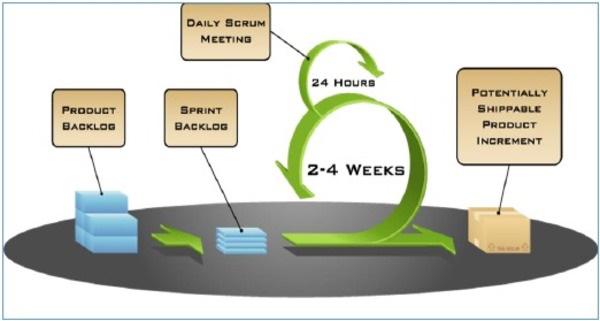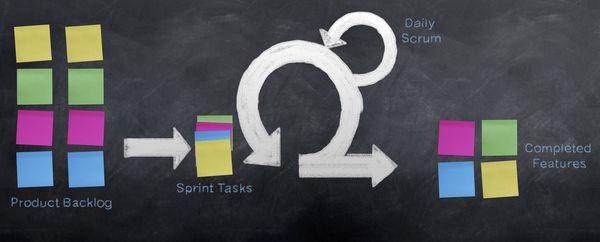Social Learning - Software SCRUM
One of the most successful Social Learning programs in today’s world is Scrum, an iteration-based, incremental agile software designed to manage product development. It provides a working environment where a development team can work as a unit to reach a common goal. It does this through its daily face-to-face communication model, allowing the members of a team to self-organize by encouraging physical co-location, and close online collaboration of all team members.
A key principle of scrum is that it acknowledges the possibility of customers changing their minds about their needs during production processes, and understands that these unpredicted challenges cannot be easily handled in a predictive or planned manner. Hence, Scrum works on an empirical approach that focuses on optimizing the team’s speedy delivery.
The Scrum framework is based on three cores −
- Scrum Master
- Sprint
- Product Backlog
Scrum Master
The job of scrum master is addressing the challenges that the team face while delivering the product goals. Instead of a traditional team lead or project manager, Scrum stands like a barrier between the team and other distractions. The scrum master ensures that the scrum process is used as intended, and often facilitates key sessions, and encourages the team to improve. It takes the responsibilities of a team facilitator.
Scrum Master Service to the Product Owner (stakeholder) −
- Providing techniques for effective Product Backlog creation and management.
- Helping the Scrum team understand product planning.
- Assisting the product owner optimize the Product Backlog.
- Facilitating Scrum events as requested or needed.
Scrum Master Service to the Development Team −
- Facilitating the Development Team with Scrum’s cross-functionality.
- Helping the Development Team in maximizing their output.
- Addressing obstacles in the path of the Scrum team.
- Coaching the team in Self-organizing events and facilitating, if requested.
Scrum Master Service to the Organization −
- Helping the organization adopt to the Scrum’s working environment.
- Organizing Scrum implementations within the organization.
- Helping employees and stakeholders understand how to use Scrum.
- Bringing changes to increase the productivity of the Scrum Team.
- Working with other Scrum Masters to increase the effectiveness of Scrum.

Sprint
A sprint (or iteration) is the basic unit of development in scrum, and is restricted to a specific duration. The duration is fixed in advance for each sprint, with two weeks being the most common. Each sprint starts with a sprint planning event that includes defining the sprint backlog, specifying the objectives and task of the sprint, and make an estimated commitment for the sprint goal. Each sprint ends with a sprint review that checks progress, and identify lessons for future improvements.
During the Sprint −
- No changes are made that would hamper the Sprint Goal.
- Quality goals do not decrease.
- Terms can be re-negotiated between Product Owner and Development Team.
Each Sprint has a clearly-defined set of instructions of what is to be done, a flexible plan to guide the team towards the result, and the resultant product. Each Sprint is treated like a project with a one-month deadline. When a Sprint’s deadlines become too long, the definition of the final result will keep changing due to numerous inputs, due to which there could be increase in complexity and risk of failure. Sprints enable predictability by inspecting the adaptation of the inputs and ideas with the progress toward a Sprint Goal at least every calendar month. Sprints also limit risk to one calendar month of cost.
Daily Scrum
The Daily Scrum is a 15-minute team-synchronizing activity where the Development Team creates a plan for the next 24 hours. This is done by inspecting the work since the last Daily Scrum and planning the layout of work that could be done before the next one. This is done to reduce complexity.
During the meeting, the Development Team members explain −
- Actions the team-members undertook to realize sprint goals previous day.
- Action that need be undertaken to meet team goals for today.
- Obstacles that are preventing or could prevent from achieving sprint goal.
The Development Team uses the Daily Scrum to see how their team’s progress is moving towards completing the work in the Sprint Backlog. The Development Team or team members often meet immediately after the Daily Scrum for detailed discussions, or to adapt, or replan, the rest of the Sprint’s work.

Sprint Review
A Sprint Review is held at the end of the Sprint, where the Scrum Team and stakeholders collaborate on the actions that should be taken next to optimize value, and the presentation of the Increment is intended to elicit feedback and foster collaboration.
Product Backlog
The Product Backlog is a list of all necessary items needed for the achieving the desired result. The unique and best thing about a Product Backlog is that it’s never complete. It starts by laying out the initial, best-known and understood requirements.
The Product Backlog evolves constantly with the users and the environment in which Scrum is used. This results in a dynamic backlog which keeps are record of evolving ideas and new inputs at every given step of the implementation, and also gives a prediction as to how these new ideas will change the final output. The product backlog exists till the product exists. Once the final product is over, the product backlog is released to another medium where others can refer to these contents and use them while designing a similar product.
With an average of 20+ active projects and increasing pressure from both internal and external stakeholders, The Information Systems department at H&R Block was always struggling with their workload. The team started to look for alternate, more efficient ways to get software out the door.
The team researched and found out that the lightweight processes of Scrum methodology were suitable to their needs as it provided a much improved efficiency and effectiveness. For H&R Block, the process was outsourced to The Braintrust Consulting Group, who conducted an initial evaluation and assessed the types of projects that H&R Block were operating, evaluated staff capabilities, and built the implementation strategy.
The employees were given a three weeks training to make them familiar with Scrum application. The H&R Block team worked on SCRUM daily; participating in sprint planning, organizing daily meetings, and guiding the team while mentoring the Scrum Master. Once the teams felt comfortable with the process, they got the confidence to get everything started to full roll-out.
In three months, the employees at H&R Block experienced a significant amount of work completion. By coordinating, evaluating, synchronizing and team-efforts, they found that they could now achieve higher efficiency and save a lot of time. Employees working on SCRUM reported 60% higher efficiency and 30% time savings.




